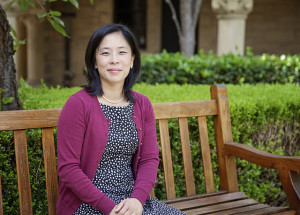I was born in Taichung, Taiwan and raised in Dallas, Texas. During high school, I attended an all-girls’ boarding school, The Hockaday School, where I was encouraged to pursue my interests in chemistry, physics and math by several amazing teachers. After completing my B.S. in chemistry at Stanford University in 2002, I took two years away from academic pursuits. I spent one year volunteering with a nonprofit group in China, taking Chinese language classes at Shandong University and working closely with Chinese undergraduate students in small cultural exchange groups. After returning to the U.S., I spent a year working in a pharmaceutical startup (Biokey Inc.) in Fremont, CA as an analytical chemist. These experiences motivated me to pursue graduate studies in chemistry with the goal of working to help remedy the devastating pollution problems I witnessed firsthand in China.
I began studying physical chemistry at Northwestern University in 2004. Working in the laboratory of Professor Franz M. Geiger, my thesis research involved utilizing nonlinear optical laser spectroscopy, sum frequency generation, to study atmospherically-relevant reactions between mineral dust surfaces and tropospheric ozone. I found evidence for a unique reaction pathway that had not been previously associated with gas phase atmospheric reactions. After completing my Ph.D. in 2009, I began working as a Dreyfus Environmental Chemistry postdoctoral fellow in the Department of Geography and Environmental Engineering at Johns Hopkins University in the laboratory of Professor Alan Stone. Simultaneously, I also worked in the laboratory of Professor Justine Roth in the Department of Chemistry. Using the analytical techniques capillary electrophoresis, electron paramagnetic resonance spectroscopy and stopped-flow UV-vis spectrometry, I studied manganese metal complexes in aqueous solutions that both mimicked groundwater as well as biological environments. I monitored oxidation reactions of small organic compounds derived from lignin and natural organic matter. At the conclusion of my 2-year postdoctoral fellowship, I chose to expand my environmental interests to gain a better understanding of biological systems relevant to human health.
Therefore, I began a postdoctoral position in the laboratory of Professor John Conboy at the University of Utah. I used nonlinear optical laser spectroscopies (sum frequency and second harmonic generation) to investigate the mechanism by which breast cancer drugs (raloxifene, tamoxifen and tamoxifen metabolites) interact with lipid bilayers which mimic human breast cell membranes. These studies helped to clarify the mechanism by which drugs are transported across the cell membrane and provide insight for medicinal chemists to design better pharmaceuticals with improved bioavailability and higher efficacy. I also investigated protein targets of breast cancer drugs by immobilizing estrogen receptors in the plasma membrane. For more information, see my publication in J. Am. Chem. Soc.
Since beginning my position as a Clare Boothe Luce assistant professor at Santa Clara University in 2014, I have trained 26 undergraduate student researchers. My philosophy is to allow students to gain hands-on research experience in a physical chemistry laboratory as soon as a student has completed general chemistry. Students conduct experiments that reinforce basic chemical theories such as calculating molarity, pH, and ionic strength. Students learn spectroscopy and thermodynamics by conducting experiments that can help inform design of drugs that can improve human health. Recording and analyzing adsorption isotherm data allow students to evaluate reproducibility, calculate error and use statistical analysis methods. Safety culture and the ethics of reliable, reproducible data collection to generate publishable measurements are emphasized. During weekly group meetings, I train students to read and discuss scientific literature and make presentations. To date, 15 undergraduate research students have presented poster and/or oral presentations at national meetings of the American Chemical Society (ACS), the (SACNAS) the Pacific Conference on Spectroscopy and Dynamics (a.k.a. Western Spectroscopy), and the Peptoid Summit.

Recent Comments